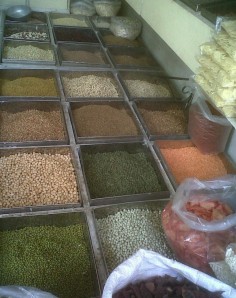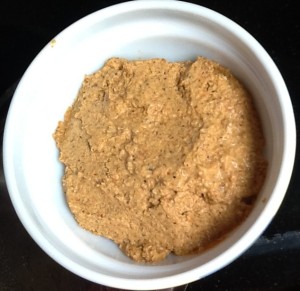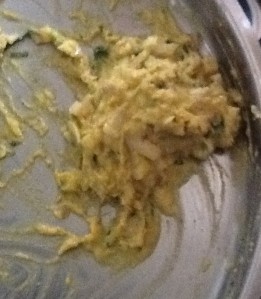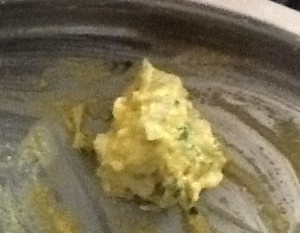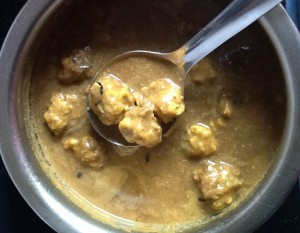It has been many many months since we made ‘Tisrya’ (clams) at home – so it was decided that the situation has to be rectified promptly. Result was an oh-so-wonderful, Tisrya-focused, lazy Sunday lunch…as only Sunday lunches can be. So I decided I should be prompt enough in posting the recipe as well. So here goes…
Tisrya are made in many ways in the konkan region – sukha (dry), with gravy (which in turn can be a thick or watery), etc. This is the gravy-wala recipe.
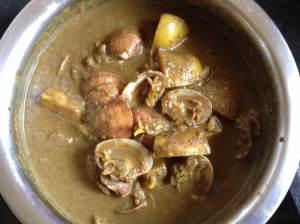
BTW, for folks like me, cleaning & prepping the Tisrya itself is a learning. So for similar ignoramus/ novice folks, have done a detailed note below (after the recipe) on this aspect.
A couple of fundas before I begin:
– Like with certain other seafood, Tisrya are traditionally NOT eaten during the months of May, June, July & August (months which do not have an ‘R’ in their spelling) as it is the breeding season. While neophytes & commercial establishments ignore this, families like mine stick to this quite religiously.
– Small Tisrya are considered better – and tastier – than medium or large ones. So when you go shopping, don’t get tempted by the large guys.
Ingredients (for about 40-50 Tisrya):
General:
- Tisrya – 40-50 pieces
- Onions – 2 (medium size) – finely chopped (about 1.5 cups in volume)
- Potato – 1 (large) – cut into 8 pieces, leaving the skin intact
- Garlic – 15 pods (pounded)
- Tamarind – size of one lemon
- Hing (Asafoetida) – 1/2 tspn
- Haldi (Turmeric) – 1/2 to 3/4 tspn
- Red Chilli Powder- 1/2 tspn (can add more if your spice levels are higher)
- Garam Masala – 1/2 tspn
- oil – 2-3 tspns
- salt to taste
For the Masala:
- Onion – 1 large
- Dry Coconut (copra) – a piece of approximately 2-3″ square dimensions
- Fresh grated coconut – 1 tbspn full
- Lavang (cloves) – 4-5
- Dalchini (cinnamon) – 3-4 pieces (1 inch size)
- Whole black peppers –7-8
- Dhaney(coriander seeds) – 2 tspns
- khas khas (poppy seeds) – 1/2 tspn
- oil – 1 tspn
Procedure:
Soak the tamarind in some water and set aside
Making the Masala:
Directly roast the lone large onion directly on the gas on a slow flame till it turns black all over. Keep turning it so it gets roasted on all sides. An easy way to do this is to stick a fork into the onion so it becomes easy to keep turning it. When done, remove the blackened cover and chop into large pieces.
Similarly, roast the Dry coconut (copra) piece directly on the gas till it blackens all over. Scrape off the blackened portion slightly after it cools down – not completely though. The blackened portion adds to the taste. Then pound the copra piece well. (In kokani or marathi, this is called ‘thechaney’). Alternately, you can chop into fine pieces too
In a ‘tadka ladle’ (called ‘pali’ in kokani/marathi) or on any flat pan/tawa – add 1 tspn oil, the lavang (cloves), dalchini (cinnamon), black pepper and dhaney (coriander seeds) and roast well. Basically the dhaney have to get roasted well till they slightly change colour. Turned off the gas, then add the khus khus and mix well. The reason why the khus khus is added after the gas is turned off is because, otherwise, the khus khus gets burnt. Wait till this mix cools down.
Grind this along with the roasted onion, roasted copra and fresh grated coconut into a fine paste. The trick is to first run the mixie with these ingredients as is for one round, then add a little water and run it again. The resultant paste should be thick (not watery) and fine. Keep aside
Making the Dish:
In a pan, in 2-3 tspns of heated oil, add the pounded garlic pods, hing (asafoetida), haldi, finely chopped onions and salt (note that Tisrya are a salty seafood – so you need hardly about 3/4th tspn of salt for this quantum of Tisrya). Roast till the onion gets a little soft. Then add the large chopped pieces of potato and the cleaned Tisrya (look below for how they are cleaned and one side of the shell removed) – and add water (Note: Use the water in which the Tisrya have been first warmed – see the prepping process described below). The water has to be just enough so that it is level with the Potato+Tisrya volume – roughly the same volume. To this, add the garam masala and red chilly powder. Cover with a flat lid and add some water ON the lid. Cook over a medium flame till the onion & potatoes get cooked. The Tisrya get done in the meantime. To check if the onion is cooked, take a small bit out and press. If it is soft and disintegrates easily, it means the onion is done. The whole process should take about 10-15 minutes for this quantum of Tisrya.
Once the onions and potatoes are cooked, add the tamarind pulp and boil well for a full five minutes – till the raw smell of the tamarind goes away.
Turn down the flame to low and add the ground masala and blend well. Add water if you want the gravy to be a little more ‘liquidy’. Basically, how thick or liquidy the gravy has to be is an individual preference – so you can decide. Bring the gravy to a light boil on the low flame. And your Tisrya are done.
Like a lot of gravies from the konkan belt, this dish tastes best when it is left aside for a few hours before eating. So try and make it at least a few hours before your meal.
Tisrya masala can be eaten with chapatties or rice. Nothing like having it with Solkadhi-Rice!
CLEANING & PREPPING THE TISRYA:
This is something that I have learnt only in the recent past. Listing down the steps below so the process is clear:
– When you buy the Tisrya – first of all, make sure that they are ‘clammed shut’. If they are beginning to open up, it means that they are not fresh
– Start the cleaning by washing the Tisrya thoroughly in running water. Do it 4-5 times till any residual sand/mud is washed off.
– Next the tisrya need to be split open as only half a shell with the meat is used in the dish and the empty half-shell is discarded. My parents tell me that in the ‘old days’, the Tisrya would be split open after they are washed over a ‘Vili’ – (a traditional cutter which is actually far more effective than a knife once you get the hang of using it!). Apparently this process of cutting the tisrya open – called ‘Karlaavnay’ – is a skill and not everyone could really do it. Luckily, the next generation of super-innovative ladies like my mom have come up with a much easier way of doing this. So you basically put the washed Tisrya in a pan, add some water (a little – just a tad lesser than that required to submerge all the tisrya) and heat it for about 5-6 minutes, keeping a lid on the pan. Check from time to time – you can see the Tisrya gradually opening up. Put off the gas once they all open and let them be till they cool. IMP – DO NOT drain and chuck the water – use it for cooking as some of the flavour is drained into the water while the Tisrya are getting heated!
-This is how an ‘opened up’ Tisri looks like:
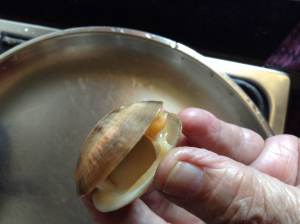
– Split this open so it looks like this (note that the two parts of the shell are still fused together at the central ‘hinge’:
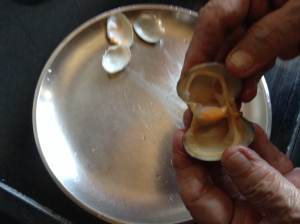
– Next take the top shell and slowly twist it while gathering the meat stuck to the bottom shell. In the process, the two shells come apart. If they don’t, pull them apart 🙂
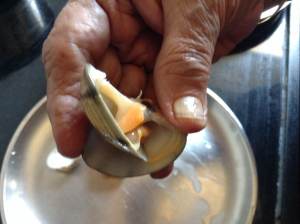
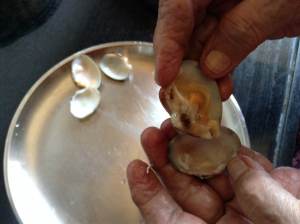
– Watch out for small silverish piece(s) that would – in all probability – be there in the meat. These are fine pieces of shell that need to be removed. In our part of the world, there is a specific name for this – called “kakri”. Getting rid of the kakri is an important aspect of cleaning tisrya. The picture below shows you what a kakri looks like:
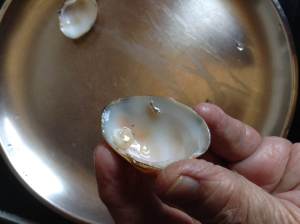
– Once you have separated the shells, gathered the meat and removed the ‘kakri’ – individually – you are ready to go ahead with cooking.
Whoever said making Tisrya was easy, huh? There is a lot of hard work involved – but well worth the effort!







